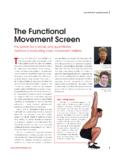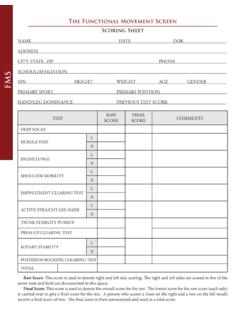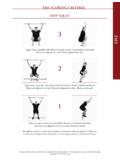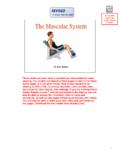Transcription of GRAY COOK The 10 Movement Principles An Expansion on …
1 ~1~This is an Expansion of Gray Cook s 10 movement principles described in his book, Movement . To learn more about the book and get more post-publication insights, please visit For more from Gray, visit him at , and for more on Movement screening, see #1 Separate painful Movement patterns from dysfunctional Movement patterns whenever possible to create clarity and produces inconsistent Movement perception and behavior. We should not exercise around or into pain hoping it will get better without first attempting to manage it systematically. The Movement screen at its core is designed to capture pain and identify situations that should be properly evaluated prior to consideration for exercises, activities and conditioning programs.
2 The Movement assessment improves clinical perspectives by separating pain and dysfunction, and placing equal focus on Movement dysfunction to manage regional interdependence. The Functional Movement Screen (FMS) separates pain by pretty much kicking out pain. If Movement causes pain, the screen is over. The Selective Functional Movement Assessment (SFMA) the medical counterpart of the Movement screen picks up where the Movement screen ends. There are two situations. If someone already knows that Movement causes pain, we go straight to a medical situation where the SFMA can be part of the overall evaluation tool. The FMS, on the other hand, is basically targeted toward people who are asymptomatic and don t have any pain, but wish to have a little more specific orientation or profiling prior to training.
3 A lot of us don t achieve our training goals. Sometimes it doesn t have anything to do with our work or our efforts. Maybe we re not aiming in the right direction. The Movement screen adjusts our aim, but in the event it uncovers pain, it also requires that we need to maybe figure out a little more about it. Pain is something that is often coupled with Movement . Since we ve been training for the last 30 years under the adage no pain, no gain, it s hard to hear a guy who s a strength coach, physical therapist or sports enthusiast being as vocal as I am about separating out the pain. It s what I ve learned about motor learning. It s what I ve learned through clinical practice for quite some time that tells me you re not going to meet a lot of your goals by working around the pain.
4 It s better to take the time to understand , I m not talking about skipping a workout on a day when your muscles are sore or tight, as I stated early on in Athletic Body in Balance. The pain we re talking about is reproducible. It s consistent and it s usually localized around a joint. Joint pain, unlike muscle soreness, is a legitimate red flag. Muscle soreness usually changes when an appropriate warm-up, foam roll or flexibility effort is performed. Sometimes the best remedy for muscle soreness from a good workout or athletic competition is actually to get moving again. That s not what we re talking about. We re talking about sharp stabbing pain, dull aching pain or pain associated with redness and swelling.
5 If you push against that type of pain, it s going to push back. It s going to push back harder and it s going to win. We need a systematic way to separate the pain and Movement , so we know the type of problem. I wish I could tell you how many email messages and questions I ve received. Hey Gray, I have low back pain. What exercise should I do? Wow, you must think I have a crystal ball!I have no idea what s causing your back pain. There is no preset program to undo what is happening to you. Your back pain could be a completely different issue than another person who s getting ready to ask the next question three minutes from now. It s a really inappropriate question if you think about it.
6 I can ask this if you re a real estate agent, Hey, what should I sell my house for? What s the next GRAY COOKThe 10 movement principles An Expansion on the Principles Section of the book, Movement ~2~This is an Expansion of Gray Cook s 10 movement principles described in his book, Movement . To learn more about the book and get more post-publication insights, please visit For more from Gray, visit him at , and for more on Movement screening, see You need more information! That s a pretty dumb question. It s not even an answer you want to hear because it s going to be wrong in a million and one cases. The first order of business is to subscribe to and use systems that fit this principle. I designed the FMS and the SFMA specifically to adhere to this principle.
7 I didn t design this principle to work with those tools. I designed those tools because I believe in this 2 The starting point for Movement learning is a reproducible Movement baseline. Professionals working in physical rehabilitation, exercise and athletics must adopt systematic approaches that transcend professional specialization and activity specificity. Movement professions need Movement -pattern standards. The book Movement develops two systems that logically rate and rank using Movement pattern fundamentals. We all come to Movement from different places. God bless those places kettlebells, Pilates, yoga, military boot camps, athletic conditioning, strongman competitions, wrestling, gymnastics, dance.
8 I could go on and come to Movement from many different methodologies, but Movement doesn t serve those methodologies. Those methodologies serve Movement . I can see how every one of those disciplines, and even more than those, could still agree on a Movement Movement baseline just creates a foundation. What do I mean when I say foundation? I don t mean strength, endurance or skill training. A foundation for Movement demonstrates that you have an appropriate perception and capacity for behavior. This means you can feel what s happening on the outside and do what s necessary on the inside. When I say foundation, I m talking about alignment, mobility, stability and functional proprioception.
9 What I m really saying is that your Movement system has the capacity to learn. If we see deficiencies, dysfunctions, asymmetries, mobility problems, motor control, stability or balance problems, we really shouldn t expect the Pilates routine to arbitrarily fix the problem. It might, and it might not. You re just hoping it ll work or you re just hoping that Turkish getups, strongman training or a little more cardio will fix the problem. But you haven t clearly defined the problem yet. It s very important to me that even though we come at Movement from different disciplines with different skill sets and different methodologies, we should at least agree on the fundamentals and basics of opening the sensory pathways and assuring that the motor pathways are a lot of different kinds of chemists, but they all work off the same periodic table of elements.
10 Mechanics working on internal combustion engines all agree on the Principles of internal combustion, even though one may be endorsing Toyota and another may be endorsing GM. Different disciplines can still have some of the same fundamental baselines. It s really funny when we get into fitness, performance and athletics that all use Movement , for some reason we invent tests that support our discipline, but that may not create those fundamental parallels. Believe it or not, a lot of the strength and conditioning techniques we use with NFL players is used in the clinic with people who have total knee replacements and vice versa. A lot of the stuff we talk about at the RKC from a Turkish getup to an arm-bar, I have used in neck therapy at the appropriate time and place.



